
Small kitchen: how to decorate with intelligence and style without sacrificing functionality? This is one of the most common challenges in compact apartments. The good news is that, by using minimalist principles and well-planned choices, it’s possible to transform this space into a fluid, organized, and personality-filled environment.
In this article, you’ll discover practical and transformative tips that will help you get the most out of your kitchen — with charm, purpose, and everyday comfort.
If you’re looking for practical solutions for compact environments, it’s also worth checking out our 10 minimalist interior design tips to maximize small spaces, with ideas that apply not only to the kitchen but to the entire home.
Understand the Challenges of a Small Kitchen
Limited space doesn’t have to mean clutter or discomfort. One of the main mistakes in small kitchens is trying to fit everything in without criteria, resulting in cluttered and dysfunctional environments. Before making any changes, it’s essential to observe how the space is being used — and what is just taking up room.
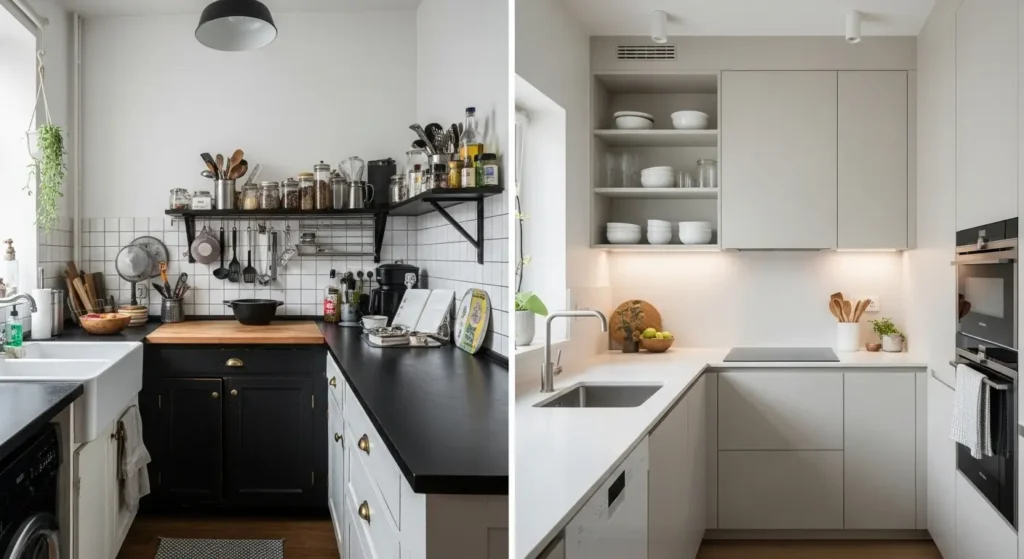
Assess the current functionality
Do a simple mapping:
- Which utensils do you actually use?
- Are there duplicate or rarely used items?
- Is the furniture optimizing or blocking the kitchen flow?
This critical look is the starting point for purposeful decoration.
Fewer items, more efficiency
In the minimalist style, each item has a clear function. Instead of filling cabinets with pans you don’t use, keep only what’s necessary. This opens up physical and mental space, facilitating routines and making the kitchen visually light.
Practical tip: A good start is to apply the 80/20 rule — you probably only use 20% of your utensils daily. Focus on those.
Opt for Light and Functional Materials
When it comes to a small kitchen, the choice of materials is one of the most powerful elements to visually expand the space and bring lightness to the environment. Light colors, smooth surfaces, and well-thought-out finishes make all the difference in aesthetics and functionality.
Why do light colors work so well?
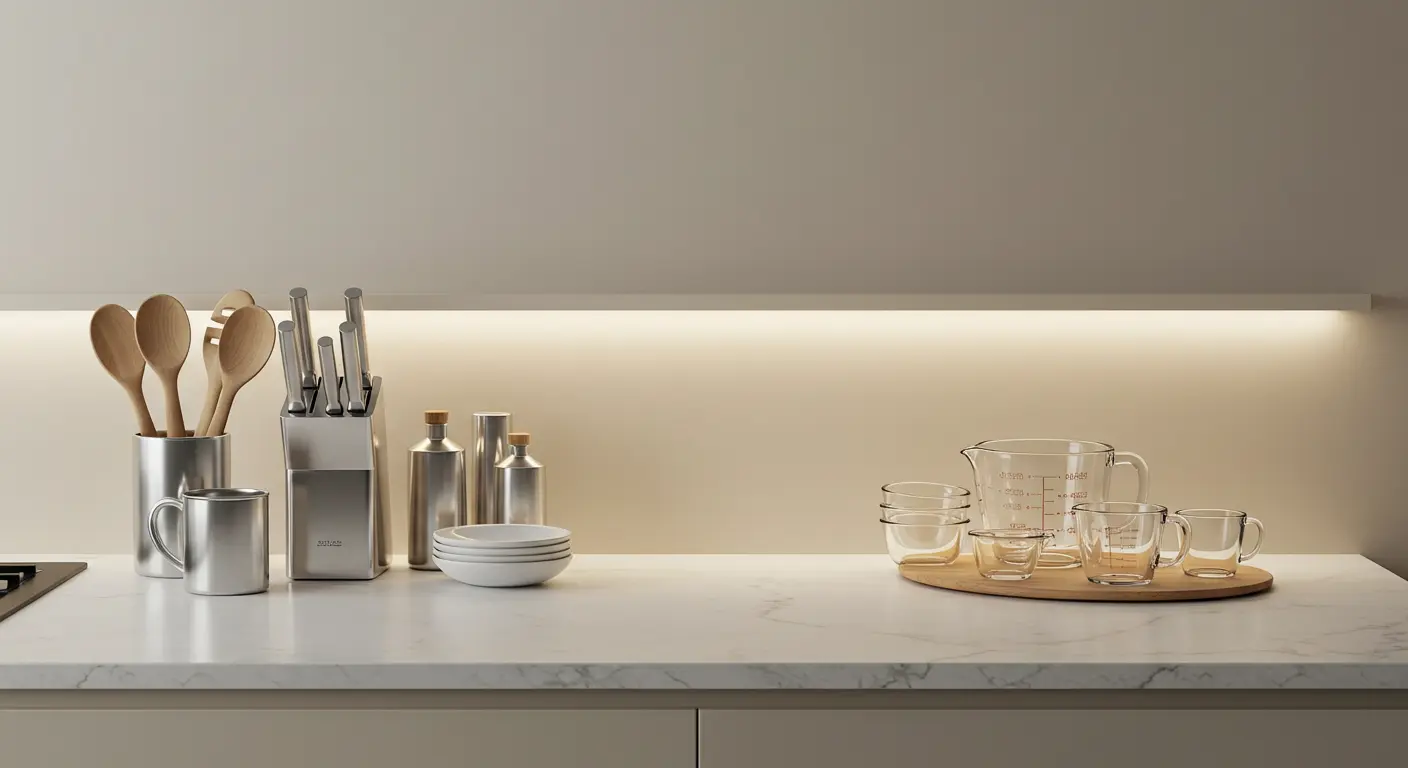
Tones like white, off-white, sand, and light gray reflect natural light better and create an immediate sense of spaciousness. These colors help keep the environment visually clean and favor organization.
Practical tip: Combine white furniture with light wood countertops or neutral-toned stones for a balance between coziness and sophistication.
Smooth and easy-to-clean surfaces
In minimalism, space maintenance is part of the concept. Therefore, opt for:
- Cabinets with a satin or matte finish (avoid excessive gloss).
- Continuous countertops, without many divisions or deep textures.
- Light-colored wall coverings with minimal grout lines, such as large tiles or well-aligned rectangular tiles.
These materials, besides being aesthetically coherent, facilitate the cleaning routine — something essential in a functional kitchen.
Functionality in every detail
The secret of minimalist decoration in compact kitchens lies in the practical details:
- Choose recessed handles or touch-to-open systems, which maintain a clean look.
- Prefer built-in appliances or those with a minimalist design.
- Use open shelves sparingly, only for frequently used items with visual appeal (like glass jars or neutral cups).
Use Vertical Solutions to Optimize Space
In small kitchens, walls are valuable allies. Often overlooked, they offer enormous potential for organization and space utilization — without compromising circulation.
Take advantage of every inch of the walls
When applying the minimalist concept, prioritize vertical solutions that combine functionality and aesthetics. Some suggestions:
- Floating shelves: ideal for frequently used utensils, glass jars, or small plants.
- Magnetic holders for knives and spices: besides freeing up drawers, they decorate lightly.
- Built-in niches or wall cabinets up to the ceiling: take advantage of the kitchen’s height without visual clutter.
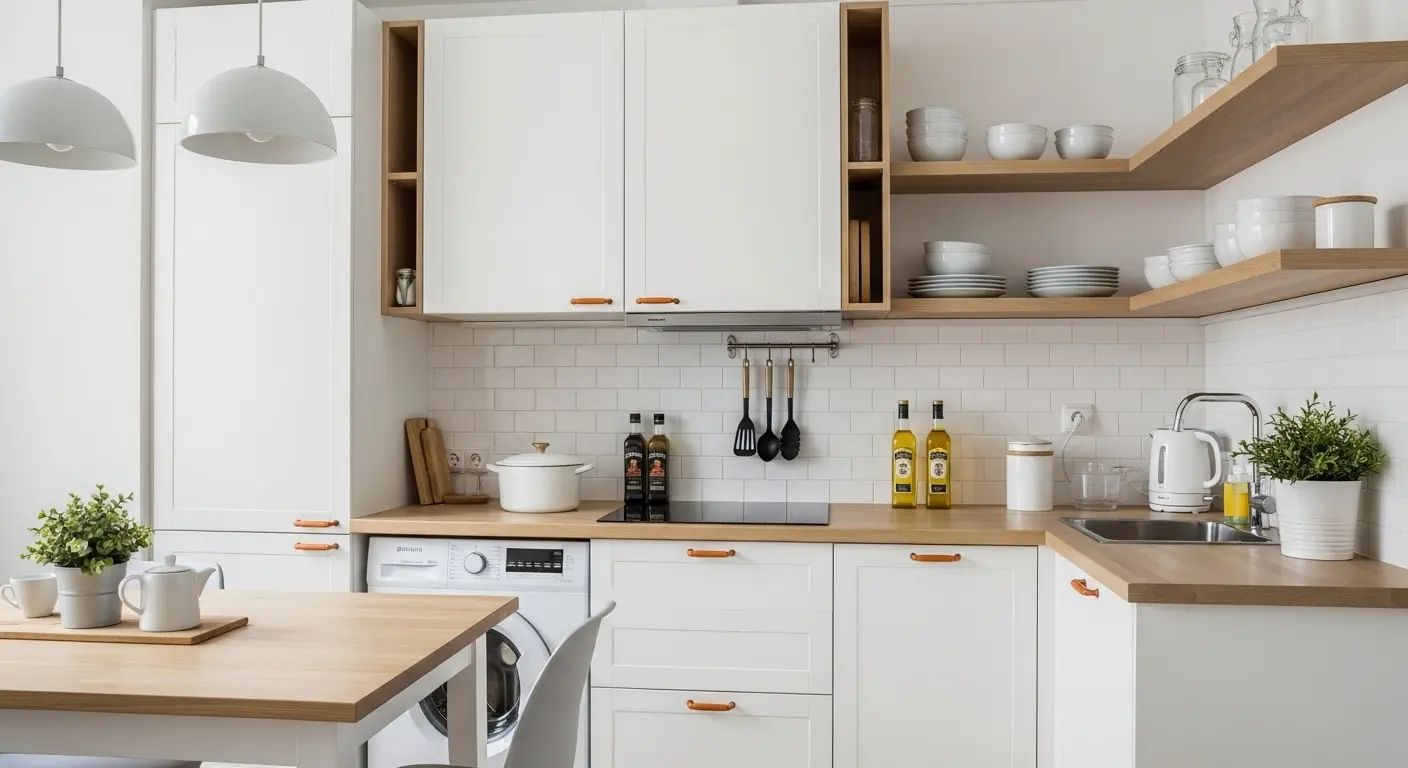
Practical tip: organize items from top to bottom according to frequency of use. Keep what you use daily more accessible.
Minimalist choices = clean look
Even with several items, it’s possible to maintain visual lightness. How?
- Standardize jars, bottles, and holders. This creates unity and avoids the feeling of clutter.
- Avoid displaying colorful objects or items with many brands. Prefer containers made of glass, light ceramic, or brushed steel.
Beware of excessive visual information
A common mistake is turning walls into excessively decorative areas. In the minimalist style, less is more — therefore:
- Limit the number of items per shelf.
- Reserve empty spaces so the eye can “breathe”.
- Value symmetry and the visual alignment of objects.
Choose Appliances with Clean Design and Smart Functionality
In a small kitchen, appliances should be considered part of the project — both in design and functionality. In the minimalist style, fewer appliances with more efficiency is the golden rule.
Prefer compact and multifunctional models
Avoid overloading the space with large, rarely used appliances. Invest in appliances that combine several functions:
- Oven with built-in microwave
- 2-burner induction cooktop
- Narrow refrigerator with smart internal layout
- Water purifier attached to the faucet
These choices ensure practicality without wasting space and also reinforce the kitchen’s clean aesthetic.

Minimalist design that harmonizes with the environment
The look of the appliances should match the kitchen’s language:
- Neutral tones (white, matte black, brushed stainless steel)
- Straight shapes and smooth surfaces
- Absence of visible buttons or flashy logos
Tip: If possible, opt to build in the oven, refrigerator, or microwave into planned cabinets. This creates visual unity and a sense of continuity.
Less noise, more lightness
Minimalism also refers to the reduction of visual and auditory stimuli. Therefore, when choosing your appliances, consider:
- Quiet models
- Inverter technology
- Simple and intuitive digital panels
These features contribute to a calmer experience during meal preparation — and reinforce the environment’s light atmosphere.
Minimalist Organization: Every Item in Its Place
In small kitchens, organization defines the success of the environment. With the minimalist style, keeping each item in its proper place is not just an aesthetic issue — it’s a way to optimize time, reduce stress, and improve functionality in daily life.

Fewer objects in sight, more visual fluidity
Visual clutter creates a sense of disorder and diminishes the feeling of space. Therefore:
- Store utensils that are not used daily
- Avoid leaving countertops cluttered with small appliances and decorative objects
- Create clutter-free zones, such as the area around the sink and stove
Practical tip: A good minimalist rule is: if something hasn’t been used in the last 30 days, it can probably be stored or donated.
Take advantage of internal cabinet solutions
You don’t need more space — you need to use what you already have better. Some smart solutions include:
- Shelf organizers for stacking plates or containers
- Internal dividers for cutlery and small utensils
- Adhesive hooks on the inside of cabinet doors
- Drawers with adjustable modular dividers
These items allow easy access, simplified maintenance, and less accumulated clutter.
Aesthetics also organize
In minimalism, organization is visual. Labeled jars, standardized bottles, and baskets made of straw or clear acrylic create visual cohesion and practicality.
For groceries:
- Use glass jars with airtight lids
- Avoid displaying plastic or colorful packaging
- Organize by categories: grains, flours, spices, snacks
This approach creates calmer and more intuitive environments, where everything has a place — and every choice has a reason.
Colors and Materials that Enhance the Space
Choosing the right color palette and appropriate materials is fundamental to creating a small kitchen with minimalist style and maximum functionality. The right combination brings visual lightness, expands the perception of space, and reinforces the feeling of welcome — all without compromising the clean and organized aesthetic.
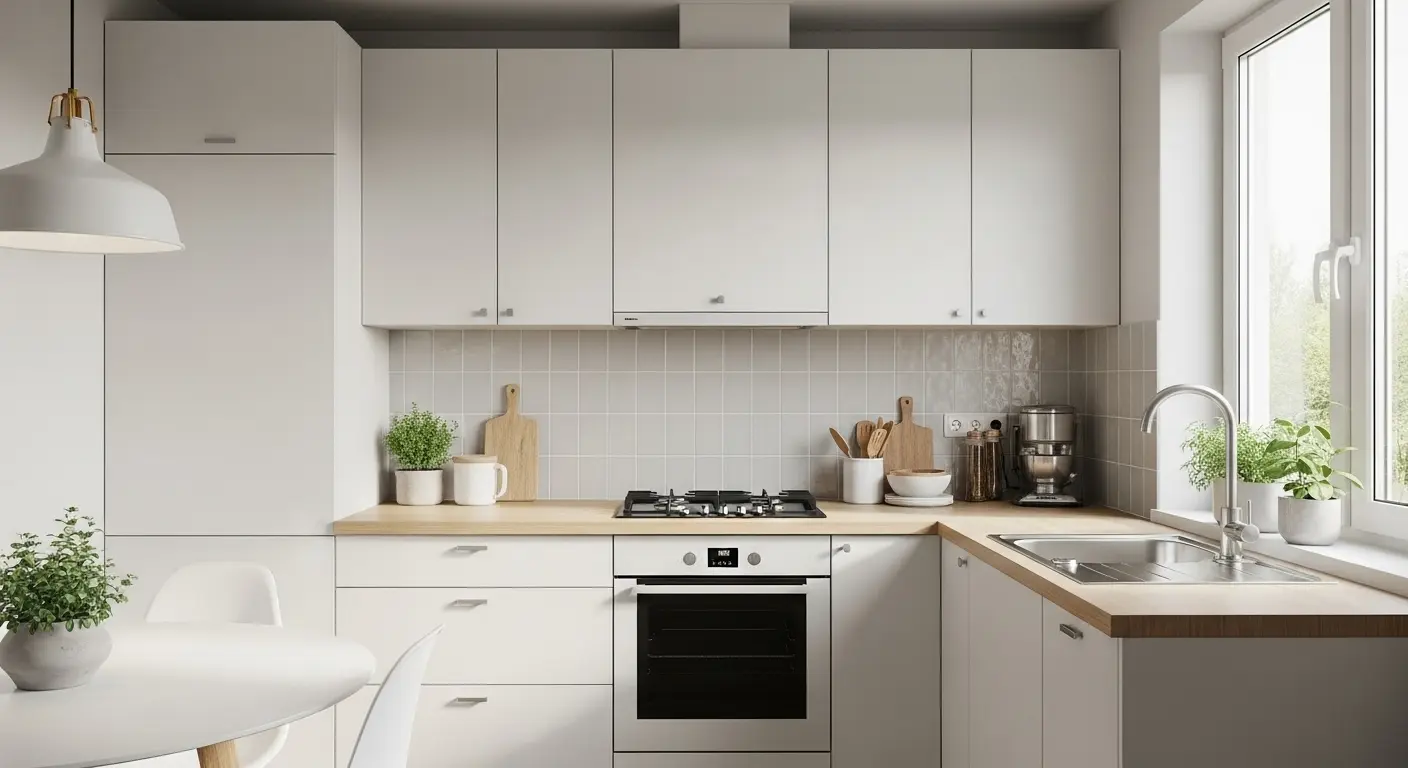
Neutral palette: the foundation of minimalism
Light and soft tones are the great allies of small kitchens:
- White, sand, light gray, and off-white visually expand the space.
- These colors reflect natural light and create a neutral background to highlight textures and specific objects.
- When used in a balanced way, they convey calm, organization, and sophistication.
For those who want a touch of color:
- Opt for soft pastel tones like olive green, grayish-blue, or terracotta.
- Use colors in small details, such as handles, utensils, or decorative objects.
Natural textures: coziness and contrast
Minimalist kitchens don’t have to be cold or impersonal. The key is to use materials that bring texture and sensoriality:
- Light wood for cabinets, shelves, or structural details.
- Natural or cementitious stones on countertops, creating visual balance.
- Artisanal ceramics and natural fibers in small accessories and organizers.
These elements warm the environment and create a more organic atmosphere, without breaking the lightness of minimalism.
Opting for finishes like light wood, brushed steel, or satin surfaces is a way to create a harmonious and welcoming look. See also how Textures and materials in minimalist design can transform the environment, adding depth and coziness with lightness.
Functional and aesthetic coverings
Opt for materials that combine ease of cleaning, durability, and discreet beauty:
- Light-colored tiles or smooth tiles in neutral tones.
- Matte finish coverings, which avoid reflections and have a softer appearance.
- Fluted or translucent glass, which elegantly conceals the internal contents of cabinets.
Bonus tip: Avoid mixing too many materials or glossy finishes. Visual uniformity is one of the pillars of minimalist design.
Decoration with Purpose — Beauty that Works
In a small kitchen with a minimalist style, decoration must go beyond the visual: it needs to have function and intention. Here, every decorative choice is strategic — there’s no room for excess or purely illustrative elements. The secret lies in composing with meaning, utility, and timeless beauty.
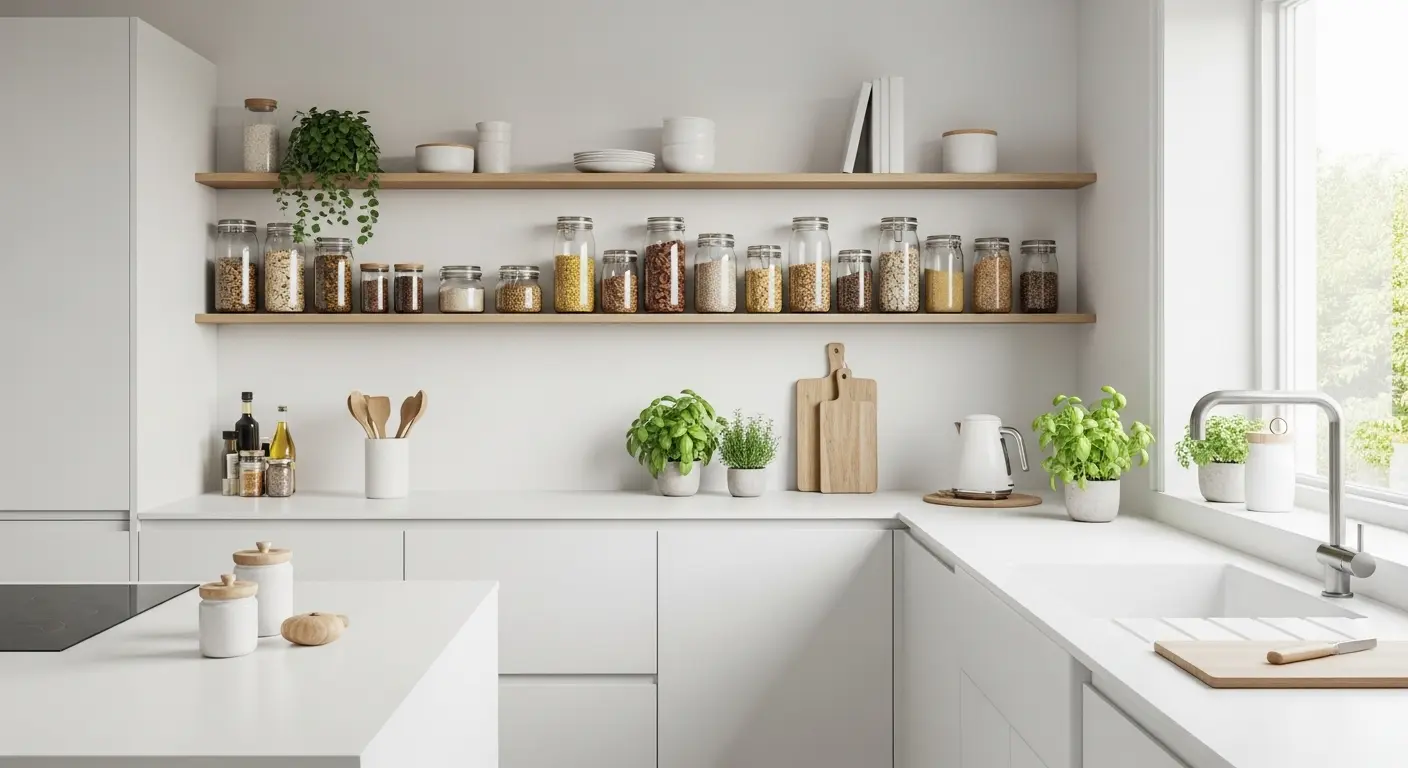
Few items, well-chosen
Minimalism doesn’t mean a total absence of ornaments, but rather the conscious presence of a few elements that make sense:
- An artisanal ceramic vase with fresh herbs
- A wooden tray to organize oils and spices
- A wall clock with a clean design
- A small frame with a light drawing or inspiring phrase
These items humanize the space, create identity, and bring coziness — without compromising visual lightness.
Natural elements: the simple charm of the essential
Bring nature indoors subtly:
- Small plants that adapt well to indoor environments (like succulents or herbs)
- Wooden cutting boards displayed vertically
- Natural fiber baskets for organizing small items
These elements add life and texture without visual noise.
Functional lighting as decoration
Good lighting transforms any space. In a small kitchen, it’s even more crucial:
- LED strips under cabinets illuminate countertops functionally and discreetly.
- A pendant light with a minimalist design over a small dining area or island.
- A portable LED lamp on a niche or shelf
Less is more: choose a light source that fulfills its function and also adds aesthetic value to the environment.
Table: Minimalist Solutions for Small Kitchens
| Common Challenge | Suggested Minimalist Solution | Main Benefit |
|---|---|---|
| Lack of dining space | Wall-mounted folding or retractable table | Space saving and everyday practicality |
| Little storage | Tall cabinets with vertical dividers + open shelves | Utilization of height and easy access |
| Cluttered look and feeling of mess | Light color palette + organization by zones | Lighter and visually expanded environment |
| Surfaces always occupied | Hooks and metal bars for hanging utensils | Freeing up countertops and more visual fluidity |
| Poor lighting | Indirect lighting under cabinets + natural light whenever possible | Cozy and functional environments |
| Lack of functionality | Built-in and multifunctional appliances (like combination microwave oven) | Maximum use of square footage without compromising design |
Conclusion – The Small Kitchen as an Ally of Minimalist Lightness
Having a small kitchen is not an obstacle — it’s an opportunity to exercise more conscious, functional, and aesthetically balanced choices. With the right strategies, you can transform this compact space into a true haven of practicality and style.
Adopting minimalism as a solution goes beyond the clean appearance. It’s about valuing what really matters: functionality, visual comfort, and well-being in daily life. Every open shelf, every visible utensil, and every chromatic choice should contribute to a fluid and intentional environment.
Remember: fewer items doesn’t mean less personality. On the contrary — by eliminating excess, you create space for what truly makes sense, reflecting your lifestyle in every detail of the decoration.
Now that you know how to decorate your small kitchen with intelligence and minimalist charm, how about putting these ideas into practice?
🟢 Choose one tip to start today.
🟢 Observe the impact on your daily life.
🟢 Feel the lightness of a functional and harmonious space.
And if you want to continue exploring smart solutions for reduced spaces, take the opportunity to also read our article How to Create a Minimalist Environment in Your Small Apartment
